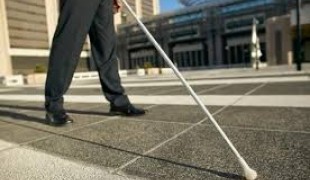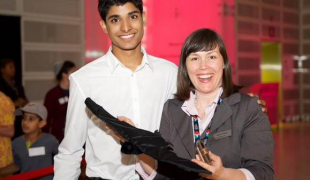- 15969
- 763
- 29
- 43
- 0
- Help Ukraine
About the solution
Shantanu is passionate about electronics, and when he saw some blind students, he decided to use his love for electronics to help them, and so he designed a smart stick to help the blind people navigate.
"I saw blind students at school having a hard time in moving around. They could not detect obstacles and would bump into them," said the young inventor. He hopes his invention will help fill this gap.
"It has infra-red sensors. The sensors are connected to a motor. When infra-red rays are reflected, the stick starts vibrating, giving warning about obstacles ahead," he said.
The equipment can be fitted on conventional stick.
"It can detect an obstacle within one feet. Now I plan to increase the range to two to three meters. I have been approached by some companies to market the invention," he said.
The easy-to-use stick, which will cost around 800 rupees (16 U.S. dollars), has brought him the Council for Scientific and Industrial Research (CSIR) Diamond Jubilee Invention Award for School Children 2010.
"I used to feel bad seeing visually-impaired students in my school bump into walls and furniture. I thought of developing something that warns them about obstacles," Shantanu said.
Adapted from: http://bit.ly/1uMl0bD
This solution shall not include mention to the use of drugs, chemicals or biologicals (including food); invasive devices; offensive, commercial or inherently dangerous content. This solution was not medically validated. Proceed with caution! If you have any doubts, please consult with a health professional.
DISCLAIMER: This story was written by someone who is not the author of the solution, therefore please be advised that, although it was written with the utmost respect for the innovation and the innovator, there can be some incorrect statements. If you find any errors please contact the patient Innovation team via info@patient-innovation.com
-
-
410
-
0
-
4743

Man develops high-tech canes to help the blind
CAREGIVING
WALKING WITH A WALKING AID: Walking with a walking aid
Blindness
Assistive Daily Life Device (to help ADL)
Walking Aid (wheelchair/walker/crutches)
Vision problems
Promoting self-management
Maintaining Balance and Mobility
Preventing (Vaccination, Protection, Falls, Research/Mapping)
Caregiving Support
Ophthalmology
India
-
-
-
402
-
0
-
6151

Parents bring together experts to create smart glasses for their son suffering from low vision
COMMUNICATION: Communicating, whether by speaking, listening, or other means
CAREGIVING
WALKING: Walking
Urban exploration
Tunnel Vision
5 Senses support devices: (glasses, hearing aids, headphones...)
Assistive Daily Life Device (to help ADL)
Vision problems
Regaining sensory function
Promoting self-management
Preventing (Vaccination, Protection, Falls, Research/Mapping)
Caregiving Support
Neurology
Ophthalmology
Pediatrics
Spain
-
-
-
376
-
0
-
3779
Student invents walking aid to help blind people to navigate
WALKING WITH A WALKING AID: Walking with a walking aid
COMMUNICATION: Communicating, whether by speaking, listening, or other means
Urban exploration
Blindness
Assistive Daily Life Device (to help ADL)
5 Senses support devices: (glasses, hearing aids, headphones...)
Difficulty communicating with environment
Confusion
Regaining sensory function
Promoting self-management
Maintaining Balance and Mobility
Preventing (Vaccination, Protection, Falls, Research/Mapping)
Ophthalmology
Canada
-

 en
en